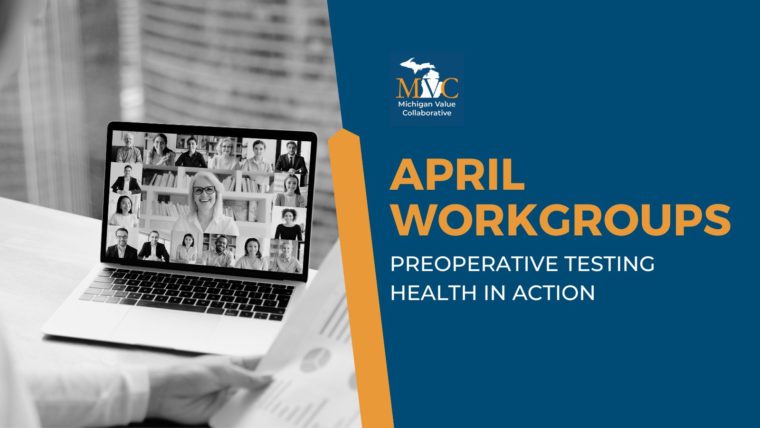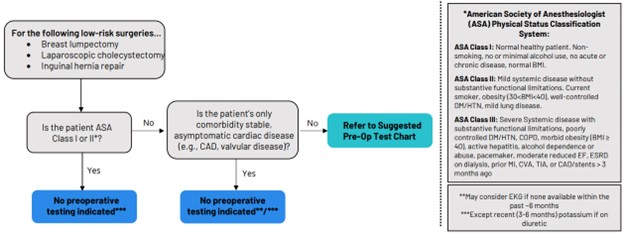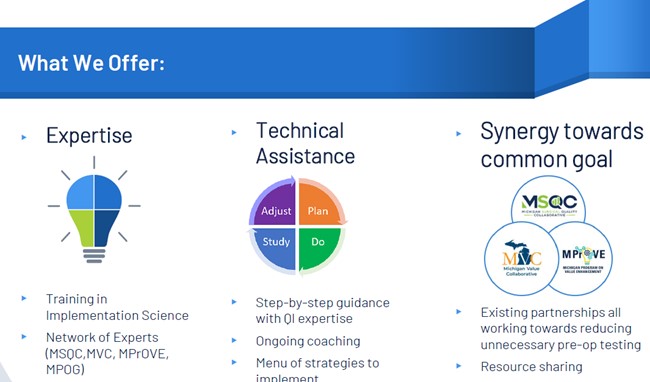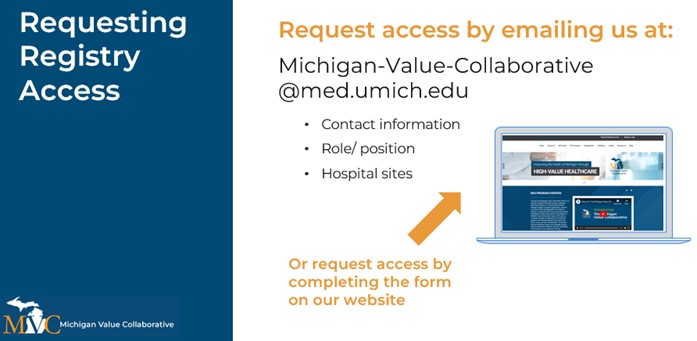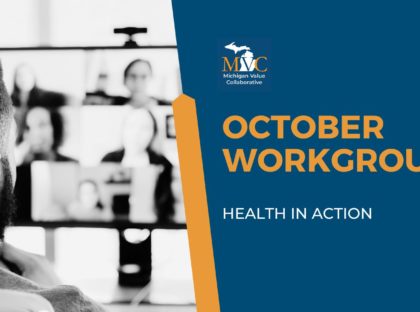In April, MVC hosted two virtual workgroup presentations – the first, a preoperative testing workgroup focused on the CQI collaboration with the Michigan Surgical Quality Collaborative (MSQC) to reduce preoperative testing rates for low-risk surgeries, supplemented by a brief overview of the RITE-Size Initiative and how MVC sites can benefit from participating. The second workgroup, health in action, focused on the recent MVC Process Measure Report and included an overview of how to utilize the MVC registry. The MVC Coordinating Center hosts workgroup presentations twice per month covering a variety of topics including post-discharge follow-up, sepsis, cardiac rehab, rural health, preoperative testing and health in action.
Preoperative Testing Workgroup April 8, 2025
Jennifer Bennett, MBA, BSN, RN, Lead Quality and Patient Safety Coordinator for Henry Ford Health (HFH) Madison Heights – Warren, shared that in 2017 the estimated cost for unnecessary preoperative testing and treatment was $200 billion nationwide (Healthcare Finance News, 2017). Additionally, in 2014, PerryUndem and the Choosing Wisely Campaign completed a phone survey of over 600 different physicians (primary care and specialists) across the country. This survey inquired whether providers believed unnecessary tests and procedures in the healthcare system were a serious problem and who or what entity should be responsible for leading improvement efforts.
Results showed that the top reasons providers ordered the unnecessary tests were because of malpractice concerns, belief that it should be done “just to be safe,” patients insisting on having the test, or they were trying to keep patients happy (Figure 1). Providers also believed they were the best suited to address overuse of unnecessary tests and procedures in the healthcare system.
Figure 1. Reasons Why Physicians Order Unnecessary Tests Poll
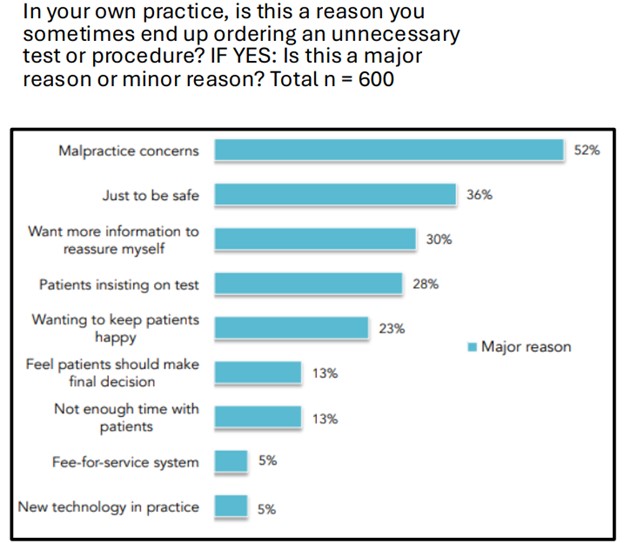
Physicians surveyed selected several solutions to try and address the issue including malpractice reform, having specific evidence-based recommendations in a format that would be easy to discuss with the patient, having more time to discuss alternatives with patients, and changing the system of financial rewards for preoperative testing metrics (Figure 2).
Figure 2. Possible Preoperative Testing Reduction Strategies Poll
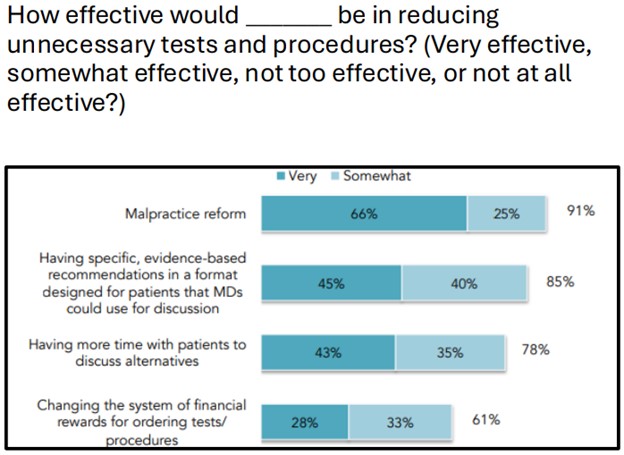
In collaboration with MSQC, Henry Ford Health Madison Heights-Warren launched a pilot program in 2023 to implement appropriate preoperative screening for low-risk surgeries, including breast lumpectomy – partial mastectomy, minor hernia, and laparoscopic cholecystectomy. Initial data used for setting a baseline understanding showed that preoperative testing rates for these procedures across the state had a wide range of 8% - 85%, and testing before low-risk surgeries was noted to be common for greater than 50% of patients undergoing at least one test.
Using testing recommendations from several notable academic medical societies, Henry Ford and MSQC were able to build an outline of recommendations for blood work (labs), electrocardiogram (ECG) tests, cardiac stress tests, and chest x-rays. A decision tree was developed to aid providers in choosing a test that was appropriate for a patient prior to their procedure (Figure 3).
This decision tree took into consideration what American Society of Anesthesiologist (ASA) class the patient fell under. The ASA classes (ASA 1 – 5) are determined by physical status of the patient (Do they have comorbidities, age related issues, life expectancy if they don’t have the procedure, etc.?) The higher the ASA class level the more likely the patient will require additional testing due to chronic disease processes being present. Recommendations for preoperative testing on patients that are an ASA class 3 or above were combined into a guidance chart (Figure 4) to aid in test order decision making.
Figure 4. Suggested Preoperative Tests for Patients Undergoing Low-Risk Surgery Who are ASA 3 or Above*
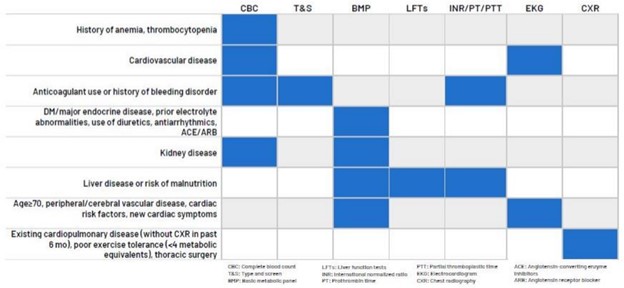
*This chart does not replace clinical judgment and is intended as guidance only.
Henry Ford Health Madison Heights-Warren reported several successes during their pilot program. These include:
- Engaging stakeholders: They successfully engaged various stakeholders—including patients, providers, office staff, CQIs, and IT—in meaningful conversations and collaborative problem-solving.
- Acknowledging work: The team emphasized the critical importance of the work being done and its alignment with the best interests of patients.
- Cost savings: They highlighted the potential for significant overall cost savings resulting from the program's implementation.
- Revising protocols: Protocols were revised to incorporate new best practices for preoperative testing, ensuring enhanced care quality.
Some of the barriers that arose included communication breakdowns, a lack of education or understanding, trying to engage and include providers that were contracted private practice and may not have the same electronic medical record (EMR) access, and not having a complete set of data due to claims data delays (Medicare/Medicaid).
Results
Prior to the pilot program launching (March 2022 - March 2023), HFH Madison Heights-Warren's preoperative testing rates were at 37.8% and after implementation (March 2023 – September 2024) their preoperative testing rate reduced to 31%. Their next steps include partnering with the RITE-Size initiative to develop future preoperative testing goals and re-engaging with stakeholders at other Henry Ford Health sites.
RITE-Size Initiative Overview
MVC Program Director Hari Nathan, MD, PhD, gave a brief overview of the RITE-Size initiative. The goal for right-sizing testing before elective surgery is to identify patient risk-level, match patient risk-level to pre-op testing, and perform a safe and successful low-risk surgery. This initiative is a grant funded collaborative partnership between Michigan Surgical Quality Collaborative (MSQC), Michigan Value Collaborative (MVC), and the Michigan Program on Value Enhancement (MPrOVE) (Figure 5). The plan is to learn from the clinical and claims data, consider clinician input, and to recommend high-value tests based on this information.
If your site is interested in participating in the RITE-size preoperative testing program, please reach out by email to the MVC Coordinating Center.
MVC Preoperative Testing Workgroup Apr. 8, 2025
Health in Action Workgroup April 24, 2025
The health in action workgroup featured a presentation by MVC’s Site Engagement Coordinator Emily Bair, MS, MPH, RDN, CSP. The presentation focused on the recent MVC Process Measure Report and included an overview of how to utilize the MVC registry.
Traditionally, MVC push reports have focused on just one condition, surgery, or metric at a time. The process measures push report was developed to pull together information on multiple conditions to provide individualized, comprehensive, and actionable insights for MVC members (Figure 6). This report was provided to sites that are participating in the MVC portion of the BCBSM P4P program as well as non-P4P sites. This allows sites to evaluate their progress on all eligible measures, not just the metrics selected for the P4P program year.
Figure 6. MVC Conditions
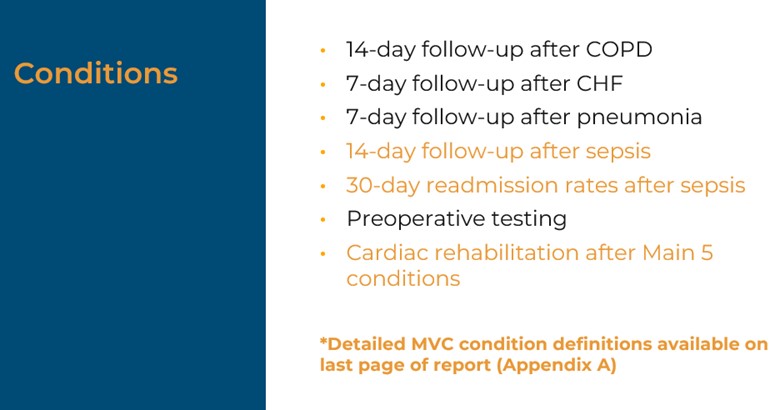
This process measures report includes 90-day inpatient or surgical episodes created from index admissions between January 2022 – December 2023. Exclusions included patients who had an inpatient hospital transfer, died in the hospital during their index hospitalization, or were discharged to hospice. Payors included Blue Care Network HMO, commercial and Medicare Advantage, Blue Cross Blue Shield of Michigan PPO commercial, and Medicare Advantage, Medicare, and Michigan Medicaid.
Within the report each site has an individualized sociodemographic overview table that displays the patient population for each process measure cohort (Figure 7). This table illustrates the distribution pattern of the population within each process measure but is not necessarily indicative of the distribution of patient demographics for the outcome of interest. One detail to note is that the race/ethnicity denominator includes all patients but may not add up to 100% due to the exclusion of other race/ethnicity categories.
Figure 7. MVC Process Measure Report for Hospital A (blinded data)
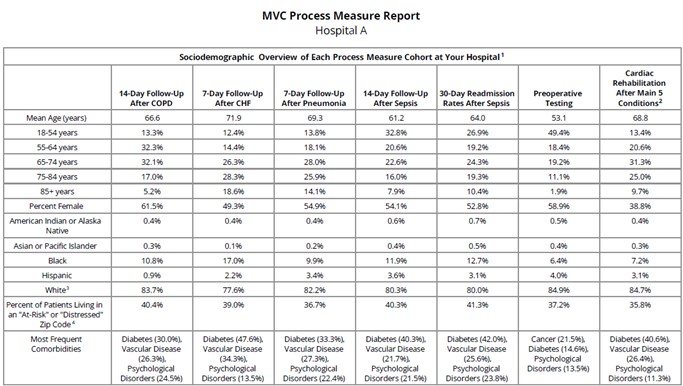
In addition to race/ethnicity categories, MVC is populating data on patient zip codes (categorized as prosperous, comfortable, mid-tier, at-risk, or distressed according to the Economic Innovation Group’s Distressed Communities Index (DCI) 2015-19. The DCI incorporates economic indicators such as education, employment, and income as well as patient age and gender. These are some of the first steps being taken to incorporate sociodemographic information into our analyses, deepening our understanding of the patient community's needs and awareness to support further health equity efforts.
Registry Review
How can we use the MVC registry to investigate certain metrics or patient demographics?
- Search for specific metrics such as preoperative testing rates at your site. Are they higher or lower than the MVC All average?
- Investigate certain procedures for which tests are being ordered more frequently than others
- Drill down to see if certain patient age categories are accumulating a higher testing rate than others
For example, when looking at the multi-payer preop testing reports, helpful filters to utilize would be the following:
- Episode start dates – selecting an exact date range
- Payers – choosing the appropriate payers for the date range you are looking at (noting that Medicare and Medicaid data may be 6 months to 1 year behind BCBSM)
- Procedures – choose the desired procedure(s) you want to investigate
- Tests – choose the desired tests you want to investigate in relation to the procedure
- Patient characteristics – choose what age(s), gender, race/ethnicity, and comorbidities you want to include/exclude
Once you send a registry request the MVC team will confirm your request with your specified site’s MVC Site Coordinator (primary contact). Once confirmed you will be sent the MVC website confidentiality agreement (WCA), and upon receiving the completed WCA, MVC will provide a username and directions to login in via email.
If you are interested in pursuing a healthcare improvement program, MVC has data specialists available to help navigate and create custom analytics reports. Please reach out to us by email if you would like to learn more about MVC data or engagement offerings!
